Effects of Zeolite and Deficit Irrigation on Sweet Pepper Growth
Abstract
:1. Introduction
2. Materials and Methods
2.1. Experimental Description and Research Design
2.2. Statistical Analysis
3. Results
3.1. Soil Water Content
3.2. Plant Growth
3.3. Principal Component Analysis
4. Discussion
5. Conclusions
Author Contributions
Funding
Data Availability Statement
Acknowledgments
Conflicts of Interest
References
- De Oliveira Neto, G.C.; Rodriguez Pinto, L.F.; Castro Amorim, M.P.; Giannetti, B.F.; Villas Bôas de Almeida, C.M. A framework of actions for strong sustainability. J. Clean. Prod. 2018, 196, 1629–1643. [Google Scholar] [CrossRef]
- Jarosz, R.; Szerement, J.; Gondek, K.; Mierzwa-Hersztek, M. The use of zeolites as an addition to fertilisers—A review. Catena 2022, 213, 106125. [Google Scholar] [CrossRef]
- Doula, M.K.; Elaiopoulos, K.; Kouloumbis, P.; Zorpas, A.A. In situ application of clinoptilolite to improve compost quality produced from pistachio bio-wastes. Fresenius Environ. Bull. 2018, 27, 1312–1318. [Google Scholar]
- Doula, M.K.; Zorpas, A.A.; Inglezakis, V.; Navvaro Pedreno, J.; Bilalis, D.J. Optimization of heavy polluted soil from olive mill waste through the implemenation of zeoilites. J. Environ. Eng. Manag. 2019, 18, 1297–1309. [Google Scholar]
- Leggo, P.J.; Ledéser, B.; Christie, G. The role of clinoptilolite in organo-zeolitic soil systems used for phytoremediation. Sci. Total Environ. 2006, 363, 1–10. [Google Scholar] [CrossRef]
- Szatanik-Kloc, A.; Szerement, J.; Adamczuk, A.; Józefaciuk, G. Effect of Low Zeolite Doses on Plants and Soil Physicochemical Properties. Materials 2021, 14, 2617. [Google Scholar] [CrossRef] [PubMed]
- Papadopoulos, A.V.; Doula, M.K.; Zorpas, A.A.; Kosmidis, S.; Assimakopoulou, A.; Kolovos, C. Pepper cultivation on a substrate consisting of soil, natural zeolite, and olive mill waste sludge: Changes in soil properties. C. R. Chim. 2020, 23, 721–732. [Google Scholar] [CrossRef]
- Nakhli, S.A.A.; Delkash, M.; Bakhshayesh, B.E.; Kazemian, H. Application of Zeolites for Sustainable Agriculture: A Review on Water and Nutrient Retention. Water Air Soil Pollut. 2017, 228, 464. [Google Scholar] [CrossRef]
- Belviso, C.; Satriani, A.; Lovelli, S.; Comegna, A.; Coppola, A.; Dragonetti, G.; Cavalcante, G.; Rivelli, A.R. Impact of zeolite from coal fly ash on soil hydrophysical properties and plant growth. Agriculture 2022, 12, 356. [Google Scholar] [CrossRef]
- Comegna, A.; Belviso, C.; Rivelli, A.R.; Coppola, A.; Dragonetti, G.; Sobhani, A.; di Prima, S.; Satriani, A.; Cavalcante, F.; Lovelli, S. Analysis of critical water flow and solute transport parameters in different soils mixed with a synthetic zeolite. Catena 2023, 228, 107150. [Google Scholar] [CrossRef]
- Castronuovo, D.; Comegna, A.; Belviso, C.; Satriani, A.; Lovelli, S. Zeolite and Ascophyllum nodosum-Based Biostimulant Effects on Spinach Gas Exchange and Growth. Agriculture 2023, 13, 754. [Google Scholar] [CrossRef]
- de Fraiture, C.; Wichelns, D.; Rockstrom, J.; Kemp-Benedict, E.; Eriyagama, N.; Gordon, L.J.; Hanjra, M.A.; Hoogeveen, J.; Huber-Lee, A.; Karlberg, L. Looking ahead to 2050: Scenarios of alternative investment approaches. In Water for Food, Water for Life: A Comprehensive Assessment of Water Management in Agriculture; Molden, D., Ed.; International Water Management Institute (IWMI): London, UK; Earthscan: Colombo, Sri Lanka, 2007; pp. 91–145. [Google Scholar]
- Lovelli, S. Dryland farming and the agronomic management of crops in arid environments. J. Agron. 2019, 18, 49–54. [Google Scholar] [CrossRef]
- Khapte, P.S.; Kumar, P.; Burman, U.; Kumar, P. Deficit irrigation in tomato: Agronomical and physio-biochemical implications. Sci. Hortic. 2019, 248, 256–264. [Google Scholar] [CrossRef]
- Pereira, L.S.; Oweis, T.; Zairi, A. Irrigation management under water scarcity. Agric. Water Manag. 2002, 57, 175–206. [Google Scholar] [CrossRef]
- Mirás-Avalos, J.M.; Pérez-Sarmiento, F.; Alcobendas, R.; Alarcón, J.J.; Mounzer, O.; Nicolás, E. Using midday stem water potential for scheduling deficit irrigation in mid–late maturing peach trees under Mediterranean conditions. Irrig. Sci. 2016, 34, 161–173. [Google Scholar] [CrossRef]
- Guang-Cheng, S.; Na, L.; Zhan-Yu, Z.; Shuang-En, Y.; Chang-ren, C. Growth, yield and water use efficiency response of greenhouse-grown hot pepper under Time-Space deficit irrigation. Sci. Hortic. 2010, 126, 172–179. [Google Scholar] [CrossRef]
- Wang, Y.; Chen, J.; Sun, Y.; Jiao, Y.; Yang, Y.; Yuan, X.; Erik Lærke, P.; Wu, Q.; Chi, D. Zeolite reduces N leaching and runoff loss while increasing rice yields under alternate wetting and drying irrigation regime. Agric. Water Manag. 2023, 277, 108130. [Google Scholar] [CrossRef]
- Silva, A.W.B.; da Silva, B.D.N.; da Costa, A.L.; Cézar, K.C.; Gomes, L.A.A.; de Oliveira, C.L. Planting density and yield of sweet pepper grown in an organic system. Pesqui. Agropecu. Bras. 2021, 56, e02470. [Google Scholar] [CrossRef]
- Al-Harbi, A.R.; Obadi, A.; Al-Omran, A.M.; Abdel-Razzak, H. Sweet peppers yield and quality as affected by biochar and compost as soil amendments under partial root irrigation. J. Saudi Soc. Agric. Sci. 2020, 19, 452–460. [Google Scholar] [CrossRef]
- Abdelkhalik, A.; Pascual, B.; Nájera, I.; Domene, M.A.; Baixauli, C.; Pascual-Seva, N. Effects of deficit irrigation on the yield and irrigation water use efficiency of drip-irrigated sweet pepper (Capsicum annuum L.) under Mediterranean conditions. Irrig. Sci. 2020, 38, 89–104. [Google Scholar] [CrossRef]
- Kumar, R.; Kumari, P.; Kumar, S. Effect of irrigation levels and frequencies on yield, quality and water use efficiency of capsicum grown under protected conditions. Int. J. Bio-Resour. Stress Manag. 2016, 7, 1290–1296. [Google Scholar] [CrossRef]
- Assimakopoulou, A.; Dimitroulia, D.; Kosmidis, S.; Doula, M.K. Growth, yield and nutrient status of pepper plants grown on a soil substrate with olive mill waste sludge and natural zeolite addition. J. Plant Nutr. 2020, 43, 629–640. [Google Scholar] [CrossRef]
- Fernández, M.D.; Gallardo, M.; Bonachela, S.; Orgaz, F.; Thompson, R.B.; Fereres, E. Water use and production of a greenhouse pepper crop under optimum and limited water supply. J. Hortic. Sci. Biotechnol. 2005, 80, 87–96. [Google Scholar] [CrossRef]
- Mardani, S.; Tabatabaei, S.H.; Pessarakli, M.; Zareabyaneh, H. Physiological responses of pepper plant (Capsicum annuum L.) to drought stress. J. Plant Nutr. 2017, 40, 1453–1464. [Google Scholar] [CrossRef]
- Belviso, C.; Cavalcante, F.; Fiore, S. Synthesis of zeolite from Italian coal fly ash: Differences in crystallization temperature using seawater instead of distilled water. Waste Manag. 2010, 30, 839–847. [Google Scholar] [CrossRef] [PubMed]
- Belviso, S.; Cavalcante, F.; Lettino, A.; Ragone, P.; Belviso, C. Fly ash as raw material for the synthesis of zeolite-encapsulated porphyrazine and metallo porphyrazine tetrapyrrolic macrocycles. Microporous Mesoporous Mater. 2016, 236, 228–234. [Google Scholar] [CrossRef]
- Sun, H.; Wu, D.; Guo, X.; Navrotsky, A. Energetics and structural evolution of Na–Ca exchanged zeolite A during heating. Phys. Chem. Chem. Phys. 2015, 17, 9241–9247. [Google Scholar] [CrossRef]
- Irrometer Company Inc. Available online: www.irrometer.com (accessed on 20 September 2023).
- Abbas, F.; Fares, A.; Fares, S. Field calibrations of soil moisture sensors in a forested watershed. Sensors 2011, 11, 6354–6369. [Google Scholar] [CrossRef]
- Scholander, P.F.; Hammel, H.T.; Bradstreet, E.D.; Hemmingsen, E.A. Sap pressure in vascular plants. Science 1965, 148, 339–346. [Google Scholar] [CrossRef]
- R Core Team. R: A Language and Environment for Statistical Computing; R Foundation for Statistical Computing: Vienna, Austria, 2023. [Google Scholar]
- Cieśla, J.; Franus, W.; Franus, M.; Kedziora, K.; Gluszczyk, J.; Szerement, J.; Jozefaciuk, G. Environmental-Friendly Modifications of Zeolite to Increase Its Sorption and Anion Exchange Properties, Physicochemical Studies of the Modified Materials. Materials 2019, 12, 3213. [Google Scholar] [CrossRef]
- Al-Busaidi, A.; Yamamoto, T.; Inoue, M.; Eneji, A.E.; Mori, Y.; Irshad, M. Effects of zeolite on soil nutrients and growth of barley following irrigation with saline water. J. Plant Nutr. 2008, 31, 1159–1173. [Google Scholar] [CrossRef]
- Ippolito, J.A.; Tarkalson, D.D.; Lehrsch, G.A. Zeolite soil application method affects inorganic nitrogen, moisture, and corn growth. Soil Sci. 2011, 176, 136–142. [Google Scholar] [CrossRef]
- Garbowski, T.; Bar-Michalczyk, D.; Charazińska, S.; Grabowska-Polanowska, B.; Kowalczyk, A.; Lochyński, P. An overview of natural soil amendments in agriculture. Soil Tillage Res. 2023, 225, 105462. [Google Scholar] [CrossRef]
- Ozbahce, A.; Tari, A.F.; Gönülal, E.; Simsekli, N.; Padem, H. The effect of zeolite applications on yield components and nutrient uptake of common bean under water stress. Arch. Agron. Soil Sci. 2015, 61, 615–626. [Google Scholar] [CrossRef]
- Ravali, C.; Rao, K.J.; Anjaiah, T.; Suresh, K. Effect of zeolite on soil physical and physico-chemical properties. Multilogic. Sci. 2020, 10, 776–781. [Google Scholar]
- Karami, S.; Hadi, H.; Tajbaksh, M.; Modarres-Sanavy, S.A.M. Effect of zeolite on nitrogen use efficiency and physiological and biomass traits of amaranth (Amaranthus hypochondriacus) under water-deficit stress conditions. J. Soil Sci. Plant Nut. 2020, 20, 1427–1441. [Google Scholar] [CrossRef]
- Doorenbos, J.; Pruitt, W.O. Crop water requirements. In FAO Irrigation and Drainage Paper; No. 24; FAO: Rome, Italy, 1977; p. 144. [Google Scholar]
- Kirda, C. Deficit irrigation scheduling based on plant growth stages showing water stress tolerance. In Deficit Irrigation Practices; Water Reports 22; Food and Agricultural Organization of the United Nations: Rome, Italy, 2002; pp. 3–10. [Google Scholar]
- Jaimez, R.E.; Vielma, O.; Rada, F.; García-Núñez, C. Effects of Water Deficit on the Dynamics of Flowering and Fruit Production in Capsicum chinense Jacq in a Tropical Semiarid Region of Venezuela. J. Agron. Crops Sci. 2000, 185, 113–119. [Google Scholar] [CrossRef]
- Dalla Costa, L.; Gianquinto, G. Water stress and watertable depth influence yield, water use efficiency, and nitrogen recovery in bell pepper: Lysimeter studies. Aust. J. Agric. Res. 2002, 53, 201–210. [Google Scholar] [CrossRef]
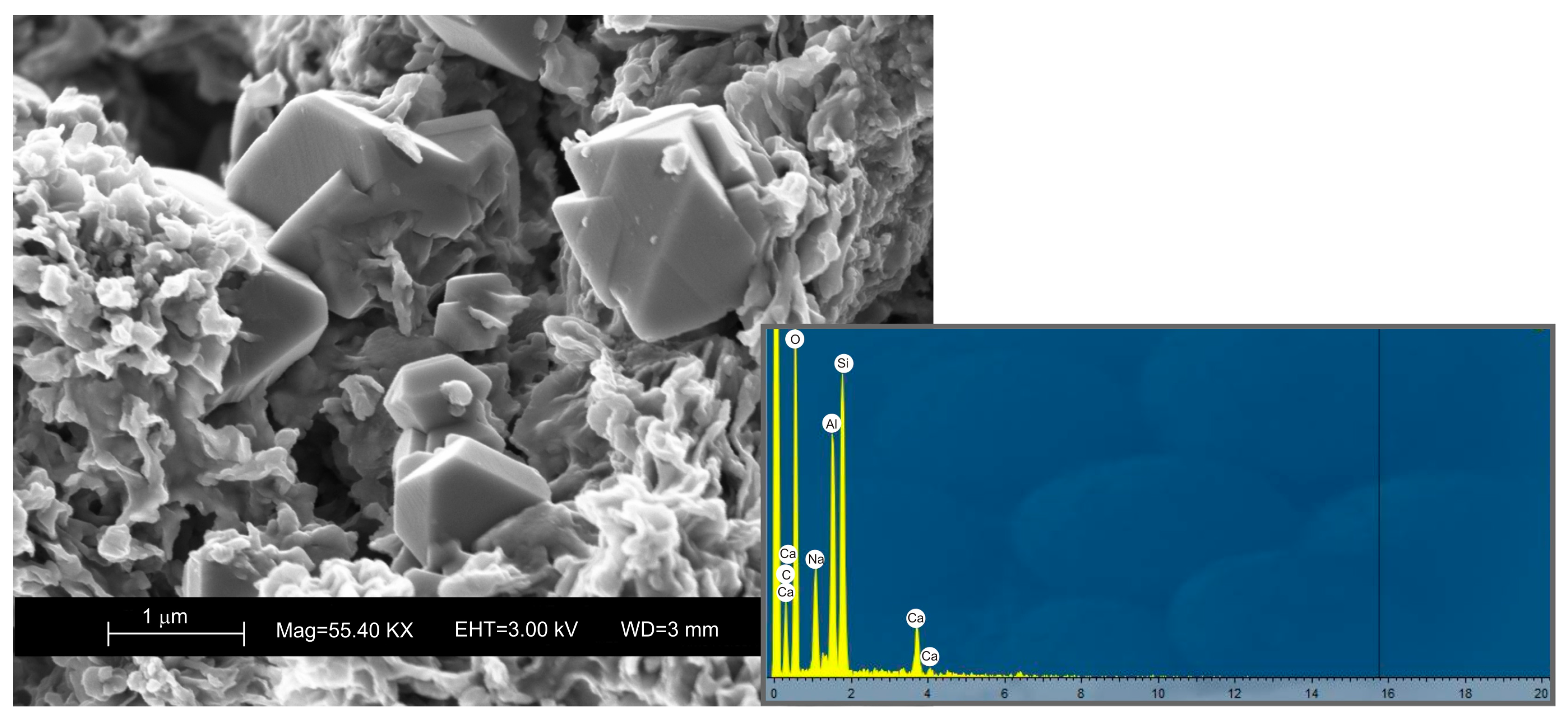
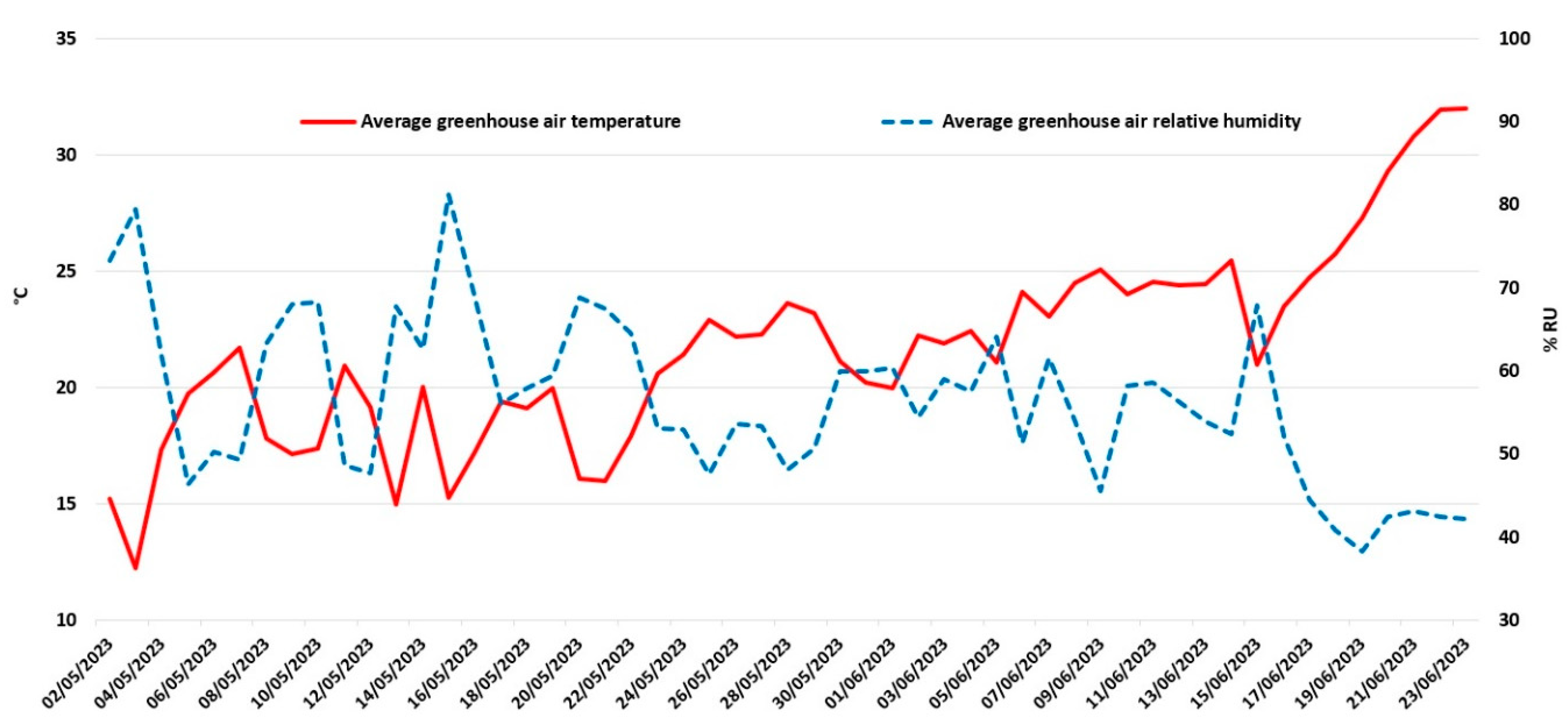
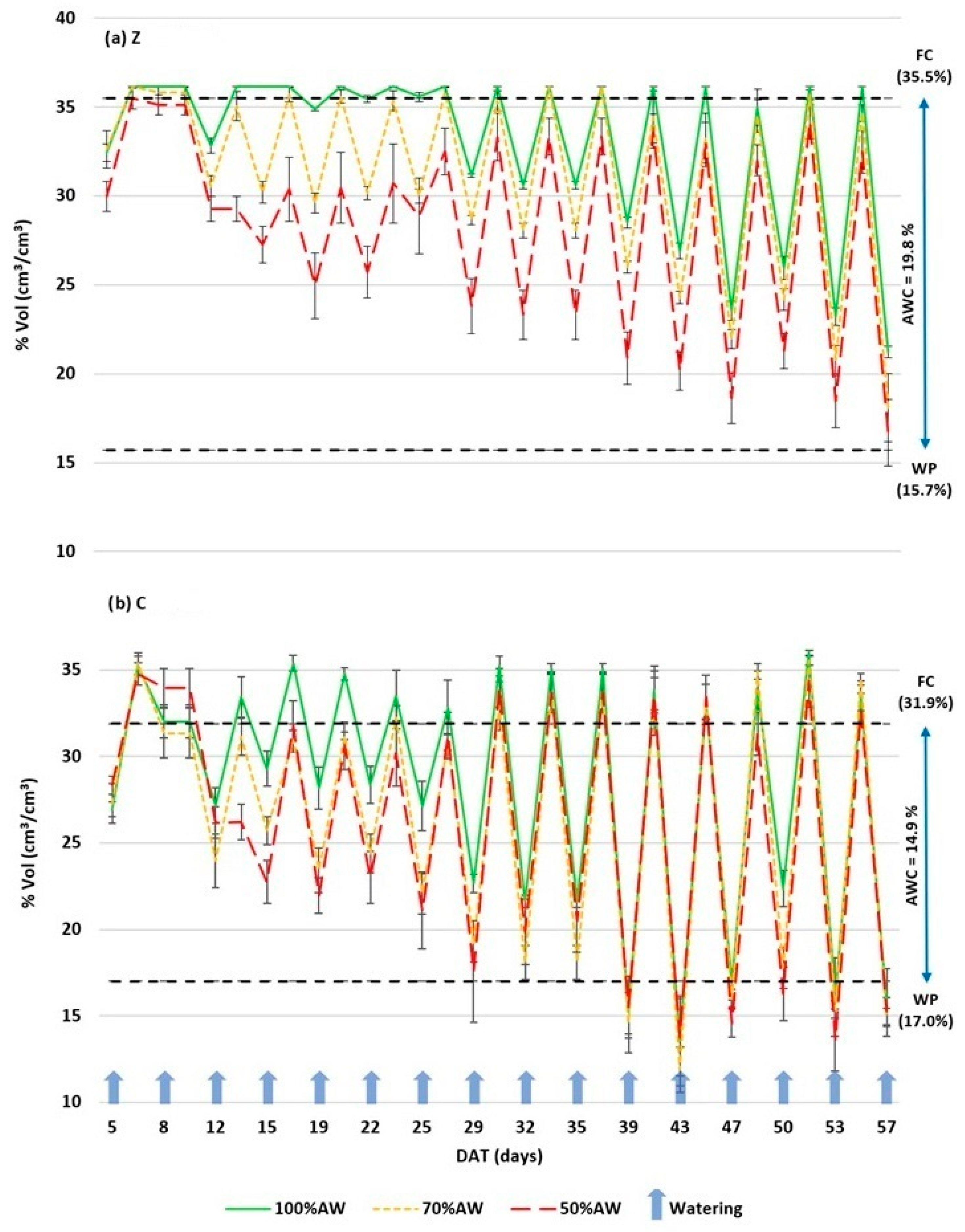


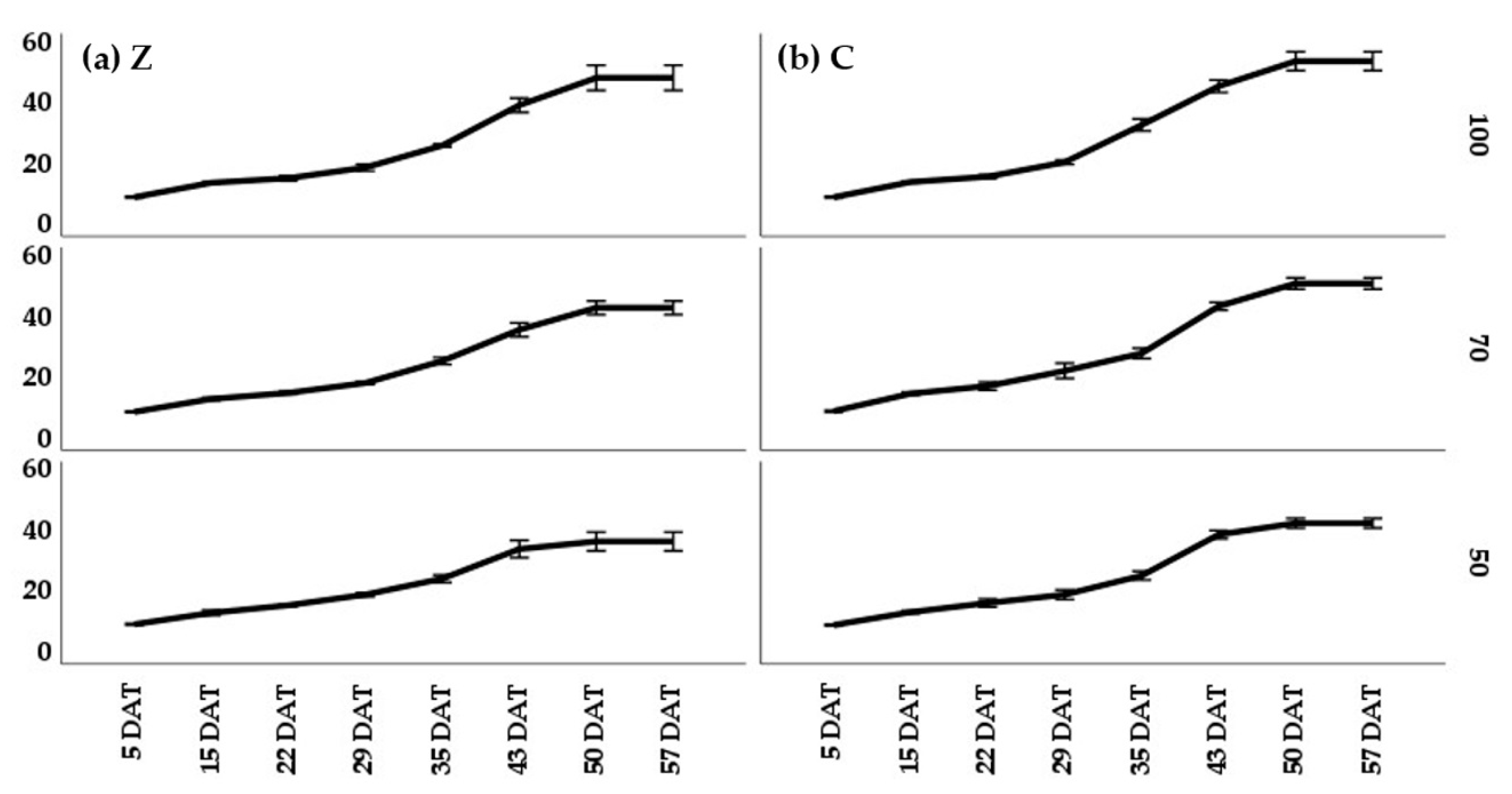
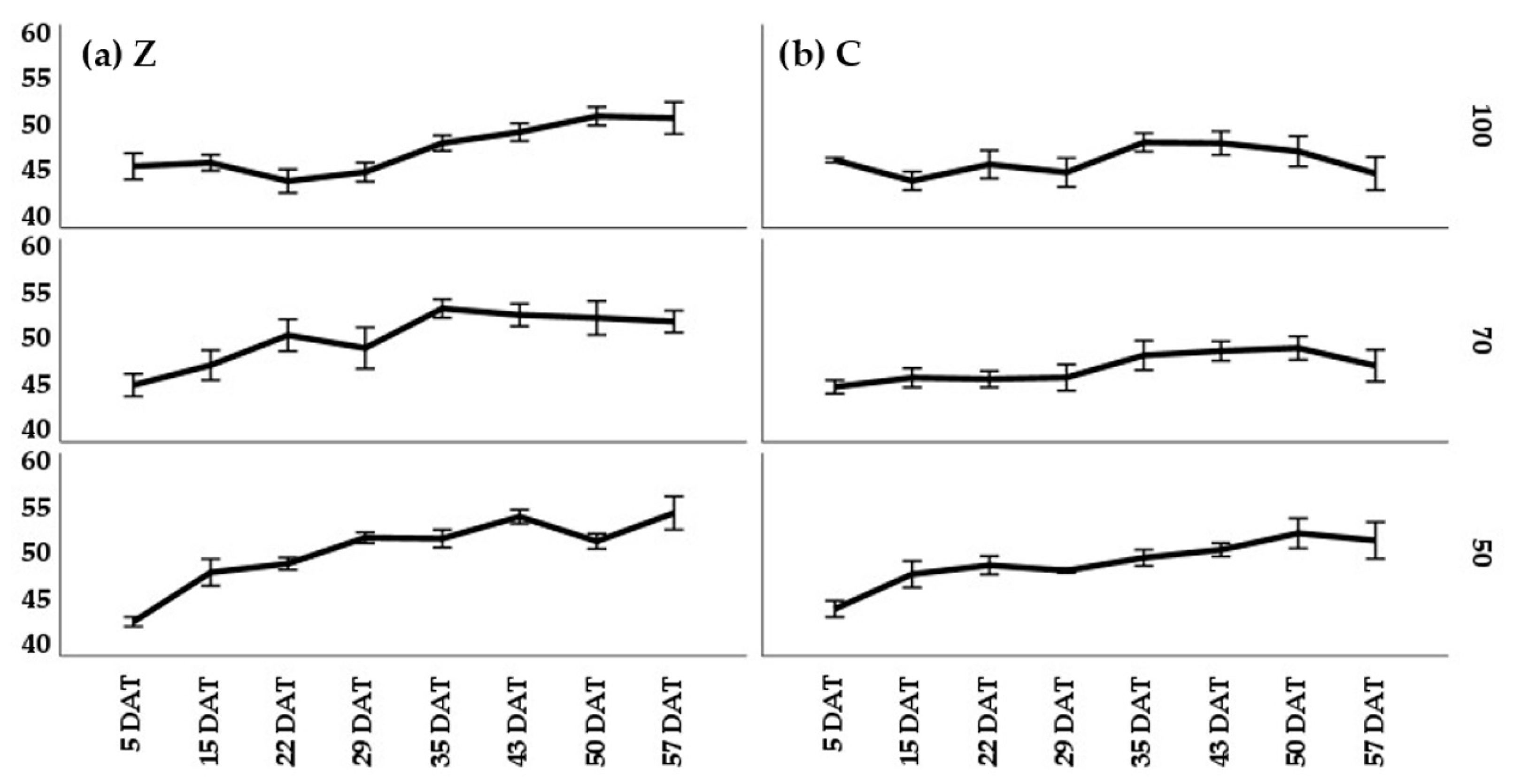
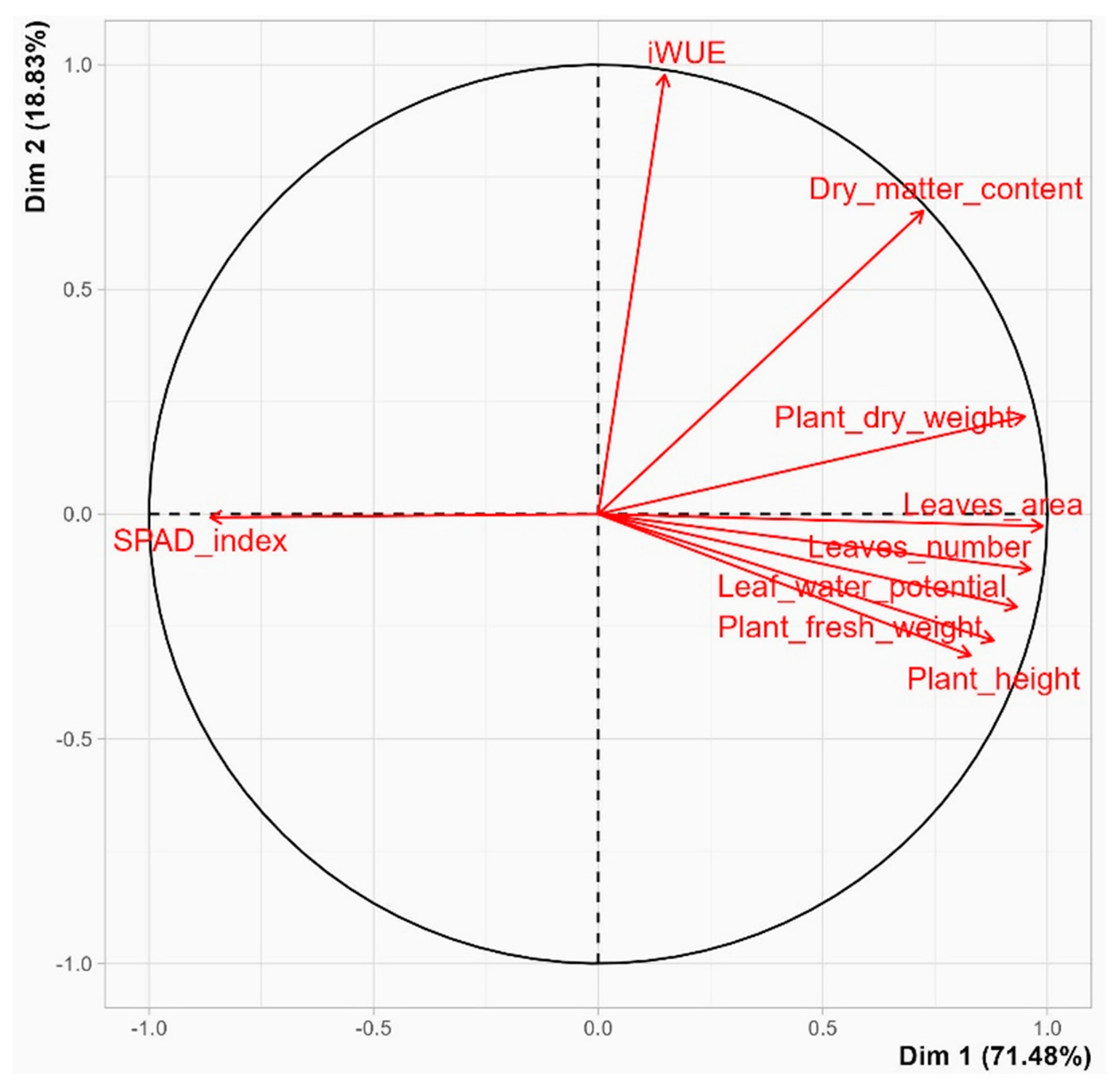
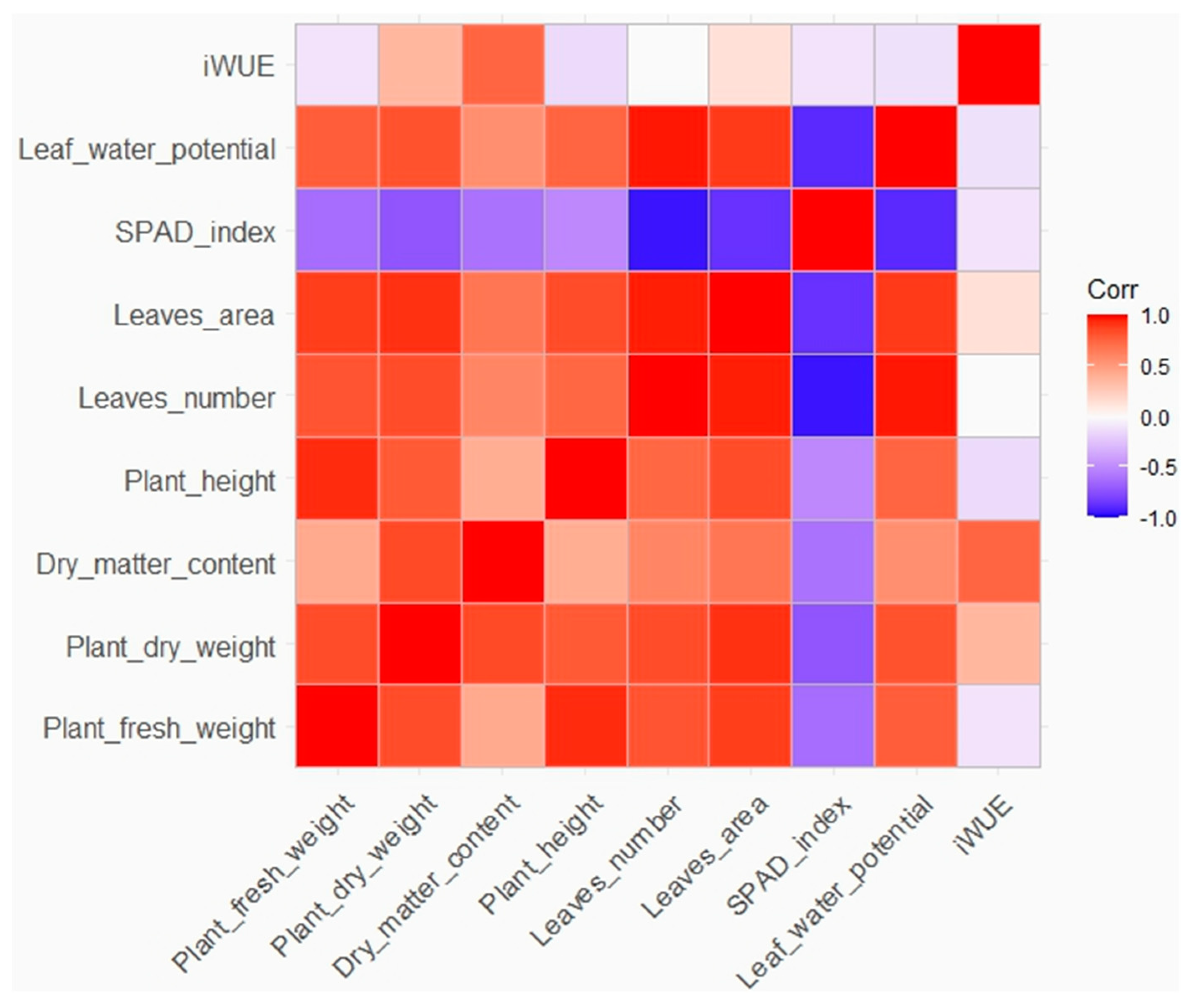
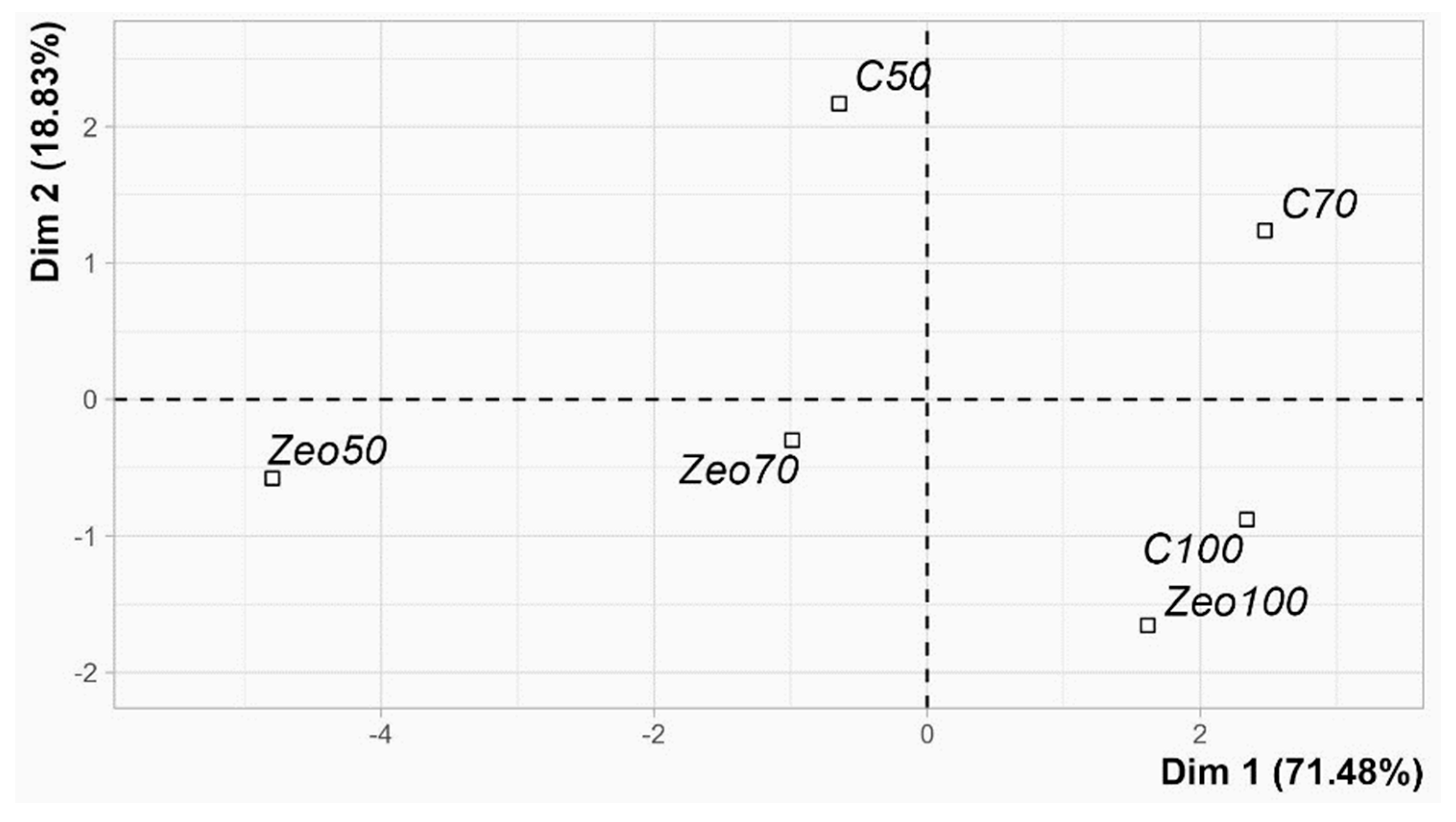
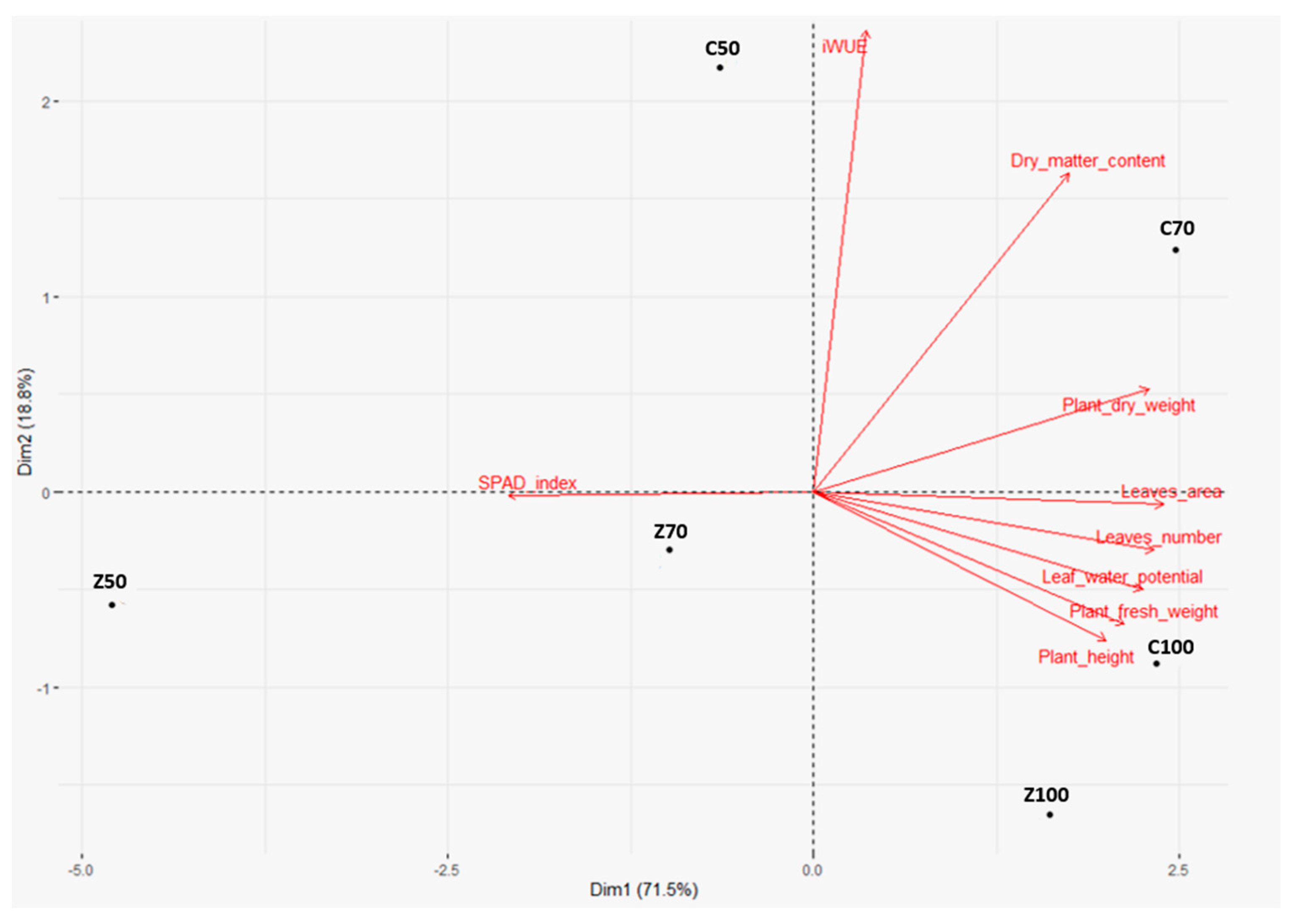
| Property | Soil | Unit | Method |
|---|---|---|---|
| Sand | 53.8 | % | Hydrometer method |
| Silt | 34.9 | % | Hydrometer method |
| Clay | 11.3 | % | Hydrometer method |
| Texture (USDA classification) | Sandy loam | ||
| Soil pedological classification | Eutric vertisols | ||
| Soil bulk density (ρb) | 1.10 | g cm−3 | Core method |
| Organic matter | 17.2 | g kg−1 | Walkley–Black |
| ECw | 0.74 | dSm−1 | BaCl2 pH 8.1 |
| pH (in H2O 1:2.5) | 7.9 | pH meter | |
| Wilting point (WP) | 17.0 | % vol | Retention curve (at h = −1.5 MPa) |
| Field capacity (FC) | 31.9 | % vol | Retention curve (at h = −0.03 MPa) |
| Soil Treatments | Field Capacity (%) | Wilting Point (%) | Available Water Content (%) | Air Capacity (%) |
|---|---|---|---|---|
| Z (2% zeolite) | 35.5 | 15.7 | 19.8 | 33.3 |
| C (0% zeolite) | 31.9 | 17.0 | 14.9 | 29.1 |
| Treatments (1) | Plant Height | Leaf Number | SPAD Index | Leaf Area | Leaf Water Potential (Ψ) | Plant Fresh Weight | Plant Dry Weight | Dry Matter Content |
|---|---|---|---|---|---|---|---|---|
| (cm) | (n.) | (cm2) | (MPa) | (g) | (g) | (%) | ||
| Z 100 | 58.00 a | 48.75 a | 50.88 ab | 1574.00 a | −1.08 b | 104.05 | 12.83 a | 12.77 |
| Z 70 | 51.25 ab | 43.50 b | 52.05 ab | 1314.00 b | −1.23 c | 93.45 | 11.88 a | 12.72 |
| Z 50 | 47.50 b | 37.00 c | 54.55 a | 1066.75 c | −1.48 e | 77.37 | 8.89 b | 11.58 |
| C 100 | 53.25 ab | 54.25 a | 44.80 b | 1628.75 a | −0.95 a | 99.18 | 12.60 a | 13.10 |
| C70 | 54.00 ab | 51.50 a | 47.23 ab | 1579.00 a | −0.95 a | 94.05 | 13.72 a | 14.56 |
| C50 | 51.00 ab | 43.00 b | 51.55 ab | 1403.75 a | −1.38 d | 90.85 | 12.23 a | 13.82 |
| Significance (2) | * | ** | * | ** | ** | n.s. | * | n.s. |
| Zeolite (Z) | ||||||||
| Z | 52.25 | 43.08 b | 52.49 a | 1318.25 b | −1.26 ab | 91.62 | 11.20 | 12.35 |
| C | 52.75 | 49.58 a | 47.86 b | 1537.17 a | −1.09 a | 94.69 | 12.85 | 13.83 |
| Significance | n.s. | * | ** | * | * | n.s. | n.s. | n.s. |
| Water regimes (W) | ||||||||
| 100 | 55.63 a | 51.50 a | 47.83 b | 1601.38 a | −1.01 a | 101.61 | 12.71 a | 12.93 |
| 70 | 52.62 a | 47.50 a | 49.64 ab | 1446.50 b | −1.09 a | 93.75 | 12.80 a | 13.64 |
| 50 | 49.25 b | 40.00 b | 53.05 a | 1235.25 c | −1.42 b | 84.11 | 10.56 b | 12.70 |
| Significance | * | ** | * | ** | ** | n.s. | * | n.s. |
| Interaction | ||||||||
| Z × W | * | ** | * | ** | ** | n.s. | * | n.s. |
Disclaimer/Publisher’s Note: The statements, opinions and data contained in all publications are solely those of the individual author(s) and contributor(s) and not of MDPI and/or the editor(s). MDPI and/or the editor(s) disclaim responsibility for any injury to people or property resulting from any ideas, methods, instructions or products referred to in the content. |
© 2023 by the authors. Licensee MDPI, Basel, Switzerland. This article is an open access article distributed under the terms and conditions of the Creative Commons Attribution (CC BY) license (https://creativecommons.org/licenses/by/4.0/).
Share and Cite
Castronuovo, D.; Satriani, A.; Rivelli, A.R.; Comegna, A.; Belviso, C.; Coppola, A.; Di Prima, S.; Cavalcante, F.; Lovelli, S. Effects of Zeolite and Deficit Irrigation on Sweet Pepper Growth. Horticulturae 2023, 9, 1230. https://doi.org/10.3390/horticulturae9111230
Castronuovo D, Satriani A, Rivelli AR, Comegna A, Belviso C, Coppola A, Di Prima S, Cavalcante F, Lovelli S. Effects of Zeolite and Deficit Irrigation on Sweet Pepper Growth. Horticulturae. 2023; 9(11):1230. https://doi.org/10.3390/horticulturae9111230
Chicago/Turabian StyleCastronuovo, Donato, Antonio Satriani, Anna Rita Rivelli, Alessandro Comegna, Claudia Belviso, Antonio Coppola, Simone Di Prima, Francesco Cavalcante, and Stella Lovelli. 2023. "Effects of Zeolite and Deficit Irrigation on Sweet Pepper Growth" Horticulturae 9, no. 11: 1230. https://doi.org/10.3390/horticulturae9111230
APA StyleCastronuovo, D., Satriani, A., Rivelli, A. R., Comegna, A., Belviso, C., Coppola, A., Di Prima, S., Cavalcante, F., & Lovelli, S. (2023). Effects of Zeolite and Deficit Irrigation on Sweet Pepper Growth. Horticulturae, 9(11), 1230. https://doi.org/10.3390/horticulturae9111230









